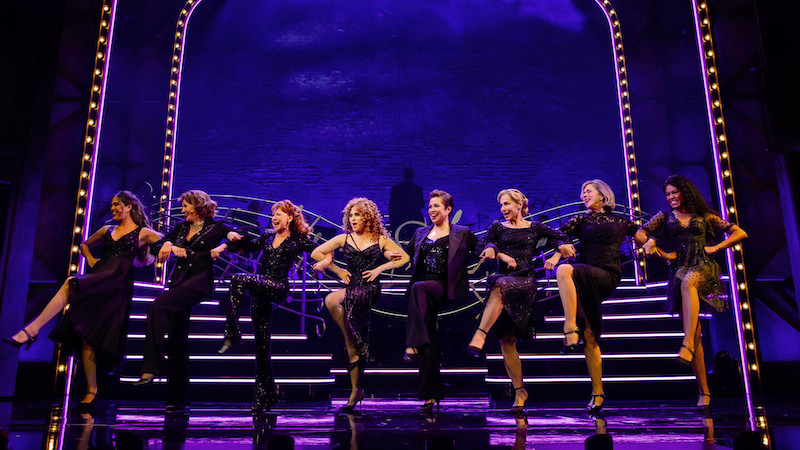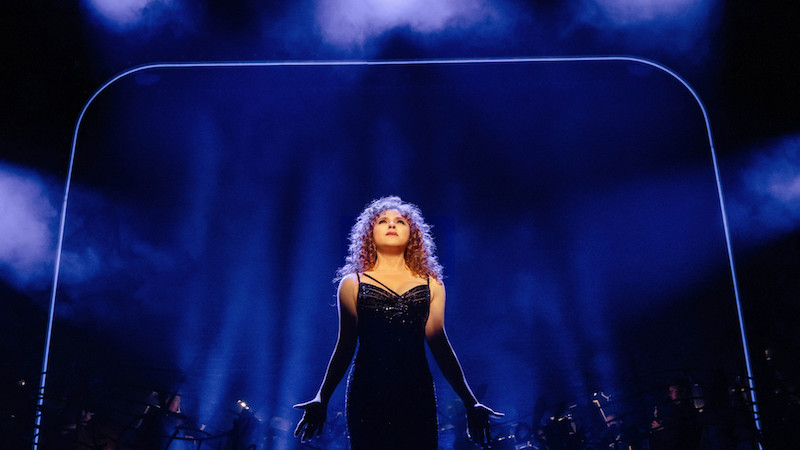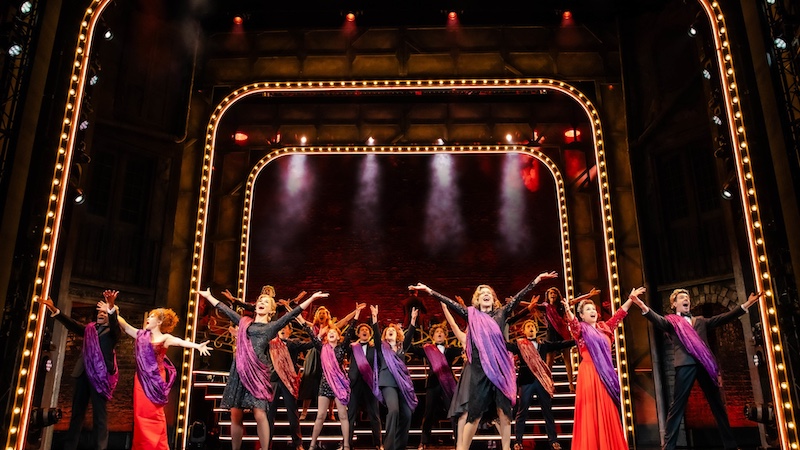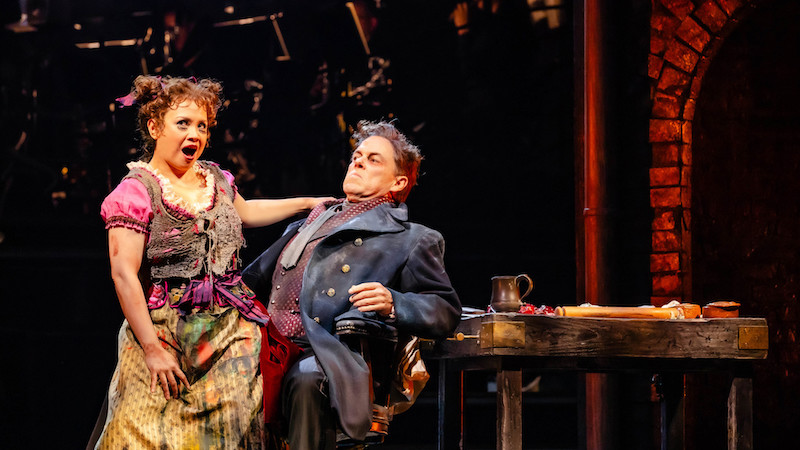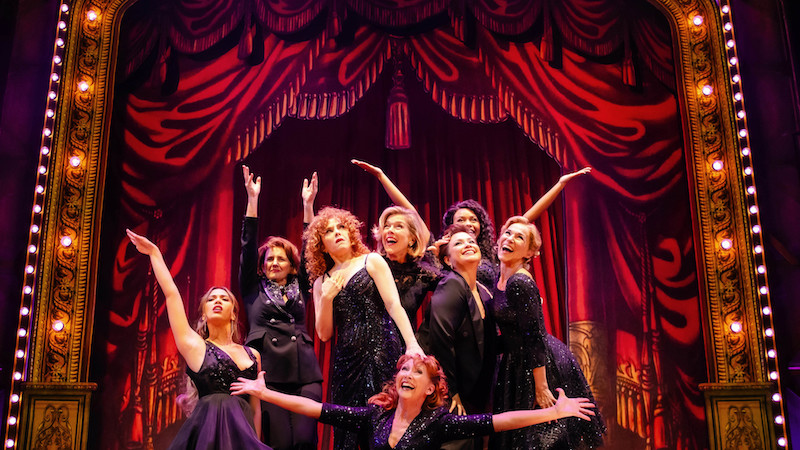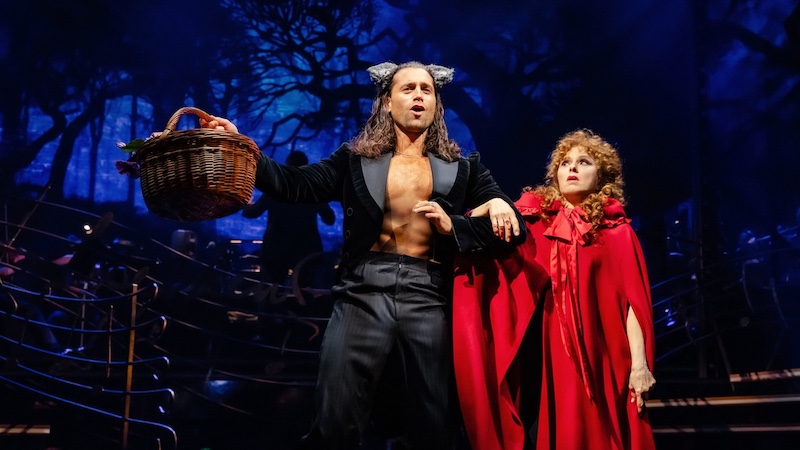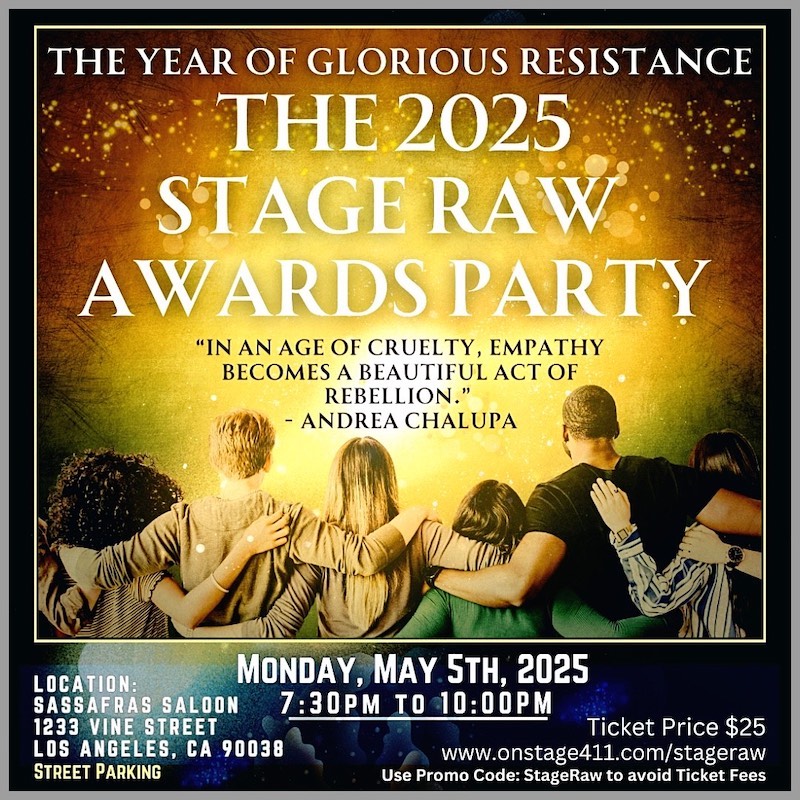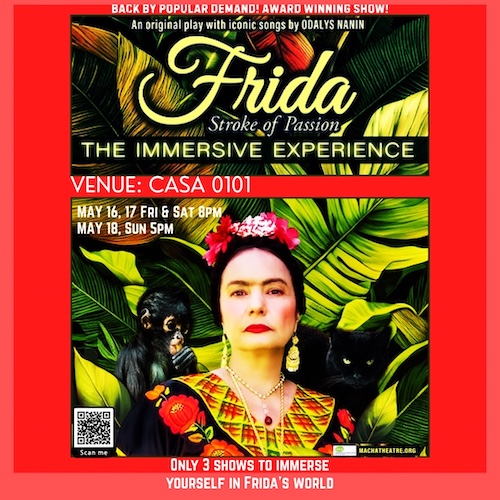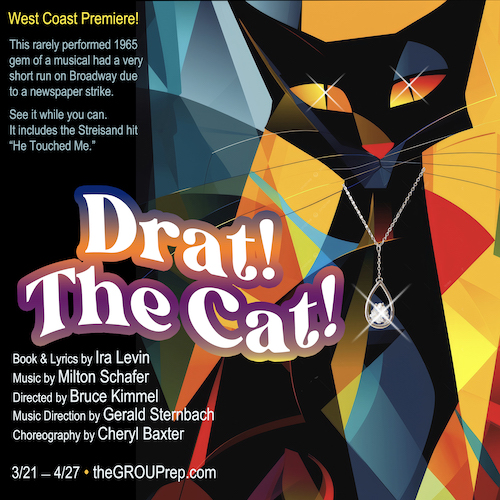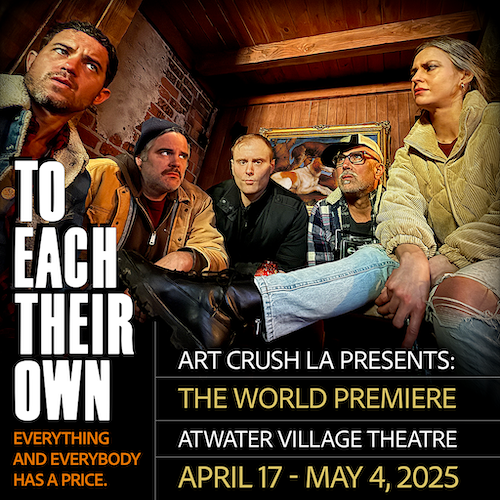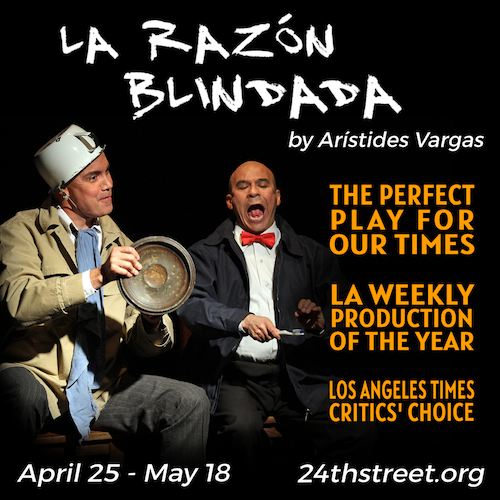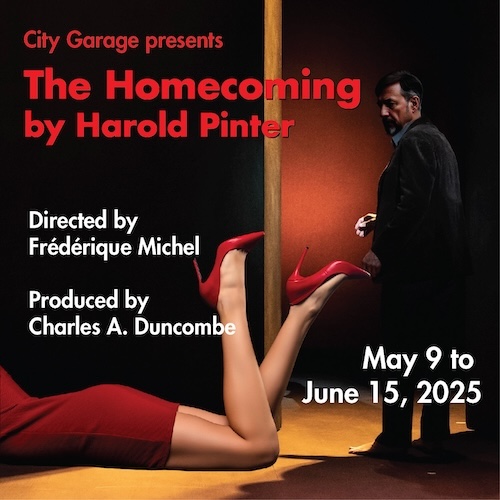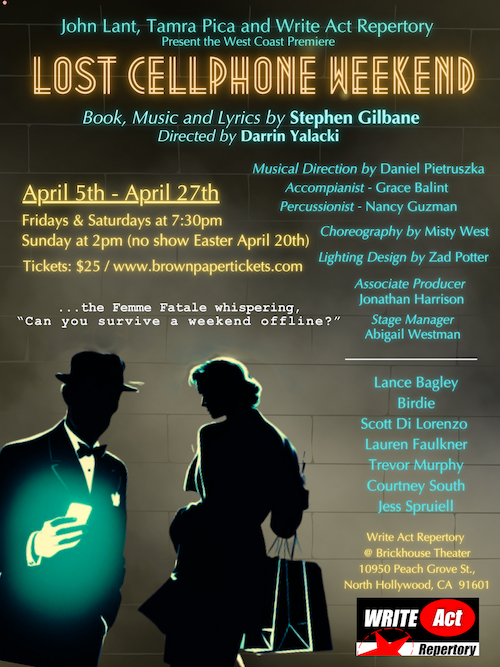Cast of “Stephen Sondheim’s Old Friends” ( Photo by Danny Kaan)
Sondheim is Bourne Again
Matthew Bourne on Directing “Stephen Sondheim’s Old Friends”
By Ann Haskins
This article is presented in partnership with L.A. Dance Chronicle
Headlined by Bernadette Peters, Lea Salonga, and a line up of British and American musical theater luminaries, the U.S. premiere of Stephen Sondheim’s Old Friends is performing at the Ahmanson Theatre, now through March 9 before going to Broadway.
After Sondheim’s death in November 2021, producer Cameron Mackintosh recruited director/choreographer Matthew Bourne and gathered a cast of the composer/lyricist’s close friends, who just happened to be stars of Broadway and London theater. The result was a one-night only, sold out gala and memorial tribute.
But once was not enough. With almost all of the original cast intact, the show had an extended London run, again directed by Bourne.Now Mackintosh and Bourne bring Stephen Sondheim’s Old Friends to LA, again with an assemblage of 14 Broadway and West End names whose friendships and long work relationships with Sondheim lend an extra level of emotion and knowledge to the show. With a multitude of his dance theater productions having their U.S. premieres at the Ahmanson, Bourne’s long and storied relationship with CTG may have helped nab the show for its U.S. premiere.
Ann Haskins recently spoke with Matthew Bourne about the one night gala that won’t stop.
Stage Raw: My understanding is your ties with Center Theater Group and the Ahmanson go back to 1995, when CTG’s artistic director Gordon Davison saw your ground-breaking Swan Lake in London and in 1997 brought your company to the Ahmanson. Since then, the Ahmanson has presented the U.S. premiere of your new works, and now Stephen Sondheim’s Old Friends. It seems a special relationship.
Matthew Bourne: It is. 1997 was the first tour date we had anywhere outside of the UK. We’ve been coming ever since with my own company’s dance shows as well as the musicals Mary Poppins and My Fair Lady. Choosing us in 1997 was taking a risk, actually a big risk, to put on a dance piece in a theater subscription season. We did New York a couple of years later with Swan Lake and other shows, yet the relationship has always been stronger with LA.
SR: Why?
MB: The audience here has become educated in the sort of stuff that I do to the point where, rather than it being a problem that it’s different, it is what they want. They know if it’s Cinderella, or Sleeping Beauty, it’s not going to be straightforward. They’re not like, ‘Oh, this isn’t what I was expecting.’ They want it to be different. The trust of an audience is an amazing thing to have. LA feels like my home in the US, definitely.
SR: Stephen Sondheim’s Old Friends is rooted in conversations that Cameron Mackintosh and Julia McKenzie had with Sondheim. Mackintosh had produced prior Sondheim revues and while Americans know McKenzie as Agatha Christie’s Miss Marple in the BBC series, she has a long career in original Sondheim casts and directing his shows. After Sondheim’s death, how did those discussions take life as a show and at what point did you come into it?
MB: Well, you’re absolutely right, Cameron and Steve talked about putting another revue together, and Stephen wanted it to be a show that celebrated him as a composer as well as the lyricist. Quite often, the revues and concerts have been the other way around. And Steve wanted as many people to see it as possible. He wanted to do a real popular revue. It was during COVID, during the pandemic lockdowns, so there were a lot of conversations. They had started to talk about a song list, and then sadly, Sondheim died. What was originally thought of as a show became the basis for a celebratory remembrance gala. It was kind of London’s tribute to him. Steve had quite a strong relationship with London and the UK over many years, with lots of productions that he’d loved. The gala drew in people who’d worked with him in London and who loved him and who were friends with him. When the gala was arranged, I was asked to come in and direct it with Julia. I said to Cameron, “What? Why me? You know, I’ve never even met Sondheim. I’ve never even worked on one of his shows.”
SR: What did Cameron Mackintosh respond?
MB: He says, ‘Oh, no, that’s rubbish. It’s about staging.’ Cameron felt I would represent Steve and him well. I resist calling him Steve, because I didn’t know him. I always want to call him Mr. Sondheim, out of respect. But it’s become the sort of shorthand now with so many involved in the show knowing him and calling him Steve. So, Cameron and I have worked together a lot, and I think the answer to your question is he trusts me. I had a great time directing this show. It is very different from everything I’ve done before. I had never really been involved in musical theater until My Fair Lady and Mary Poppins with Cameron. The Oliver we just opened in London was the first time, actually the first time I directed, properly directed a full musical. I was always involved as choreographer or musical staging or co-director.
SR: Did not being friends or knowing Sondheim actually help you direct?
MB: Yes, I think so, because I come at it solely to represent the work. For the gala and ever since, Julia McKenzie who is in her mid-80s did not want the responsibility of directing it, but she literally was ‘side by side’ with me. She sat there feeding me information, little gems of knowledge, all sorts of tips and intentions in the lyrics that she knew from her long association with Steve. Also, for the gala, I had help from Maria Friedman, another long time Sondheim collaborator. After the gala, Maria went to do Sondheim’s Merrily We Roll Along on Broadway which was a big success and won Tony awards. So for the gala, there were these two Sondheim experts and friends, plus my outsider’s eye. I was not bringing a friendship, as with Julia and Maria and many of the cast. I had no relationship, really, other than being a fan. But that turned out to be okay. As a fan, I felt I knew a lot of the material inside out. In the end, I thought, I know this work, I know this material, and can view it as an outsider.
SR: How did the one-night gala turn into a show with an extended run?
MB: We did the gala, and then very soon afterwards, Cameron brought it up. I think he already knew what he was going to do. He said, ‘I think we could make this into a show.’ The key was getting Bernadette to do it. For me, she’s the magic that threads the thing together. She has that direct connection with Sondheim. When she’s on stage, you feel that very much, and those moments are magical. The goal was to surround her with the best talent, and that’s what we’ve done both in London and here.
SR: One of the London reviews praised your contribution as adding a gloss and sheen that connected with ordinary mortals who can’t quote every lyric. Do you think that’s true and how did you do that?
MB: It was important to Steve in the early conversations that this show not just play to the fans. It does play to the fans, but at the same time, my note to the company at the outset of rehearsal was that we assume nothing. We assume the audience knows nothing about Sondheim, nothing about the shows the songs are from, and that we tell our story to people who don’t know the characters or what comes before or after this song. We tell the story in the moment of the songs. Many Sondheim songs are a little play, a complete story in themselves. What Steve wanted and what Cameron wants, is for these pieces to go on for a very long time, and for an audience, especially a young audience, to experience them and know it is a part of them, not some elitist work. I think Steve’s work was often categorized as being too sophisticated or too intellectual. It’s not actually. His songs are very clear. You don’t need several degrees to understand what he’s written. That’s an important aspect of the show.
SR: Does the success of revivals suggest Sondheim shows were just ahead of their time?
MB: I think that’s true. His shows were very unlike other work being done around at that same time. So they stood out and were considered intellectual, hard to understand, or the music was difficult, and that he couldn’t write tunes. All that is rubbish. He writes the most beautiful melodies. This show is there to say and demonstrate that those critiques are not the case.
SR: Video clips of both the gala and the London shows look different from a lot of revues or concert presentations where everyone’s just all dressed up with a minimal prop or two. The clips indicate while not a full theatrical production, there are costumes, set pieces, projections, and props. How did you make choices on when to have those theatrical elements yet keep the show moving?
MB: It was difficult to decide how far to go with each thing. The cast each has a basic costume that maybe changes in each half. We add things but their basic costume reflects what each person’s featured moments are to come. We do add some props and some costuming, just what is needed to characterize the song while retaining the revue feeling. That way, the cast can switch from one thing to another very quickly. Fortunately, the Ahmanson is very adaptable and changeable. The projections suggest things the audience needs to know about where we might be. Some songs have more of a production. Other times it’s more like a traditional revue. However, other than Bernadette’s greeting to the audience explaining what we’re there for, there’s no other talking during the show. It’s all singing. It is quite unique in that way, yet very elegant and very sophisticated, and in many ways just one showstopper after another. I always describe it as an embarrassment of riches. It’s that sort of show.
SR: There’s a choreographer credit for Stephen Mear, who worked with you on Mary Poppins. You are a celebrated choreographer, why bring in another choreographer?
MB: When we did the gala, there was such a lot to do in one week. We brought in Stephen where it really goes into dance, while I did the staging. I staged sections like Weekend in the Country from A Little Night Music and the Into the Woods section. Where it goes into more Broadway show biz movement in You Could Drive a Person Crazy from Company, Everybody Ought to Have a Maid from A Funny Thing Happened on the Way to the Forum, as well as the opening and the closing numbers, Stephen choreographed those. It was an evenly shared responsibility.
SR: How has the show evolved for the U.S.?
MB: We spent a lot of time auditioning and seeing if we could bring over some of our British casts as well as adding Americans, which we’ve done, combining the two. We have one new number that Bernadette was keen to do, a little known number from one of Steve’s last shows called Bounce. She says she’s stood in the wings and enjoyed a number in a show that she was in and wanted to do. So she is doing numbers people expect but also some surprises. For example, Bernadette was the Witch in Into the Woods, but wanted to do Little Red Riding Hood. And she does it brilliantly.
SR: Among the things that Julia McKenzie or the others said to you about their experiences with Sondheim, was there any particular thing that sticks with you?
MB: Julia used to say the answer is always there in his lyrics. Whenever you are stuck, the answer is always in the lyrics. Delve a bit deeper into those lyrics and they will tell you what to do, and also tell you what not to do as well.
SR: Were there any particular songs where you did that?
MB: There was one in particular son, Leave You from Follies, which is a great song, which we turn on its head a little bit having it sung by a man about a male partner. The new approach to the song worked very well. For me as a movement-based storyteller, the fascination with words became a bit of an obsession, which I really enjoyed. It was something I’d never done before. It’s always about telling the story. In this show, what is the story of the song? On one level, it’s not different than creating dance works without words. On another level, it’s very different, because it doesn’t rely totally on the physicality. I still want the physicality because that’s what I’ve always done. With a musical, I tend to get up and do things a bit more, and I’m sort of on the move, and I feel them. I have to feel the music, as I do with when I’m creating a dance piece, but with the added thing of the lyric as well. Interpreting music has always been very important to me with the composers I’ve interpreted or worked with on in my dance pieces. And the same here, I’ve got a very good ear for when it’s off a bit, not on the right rhythm, or not just about words.
SR: Anything else LA should know?
MB: After the terrible time here with the fires, we were a little nervous about coming with what is quite celebratory when there was such ongoing bad news. I just hope we can bring some joy and can be a healing thing. My company was here to open Car Man on 9/11. We opened a day or two later and offered free tickets to anyone who wanted to come. That sort of coming together of people seemed very healing. This show grew from Sondheim’s friends and their desire after his death to celebrate his life and work. That effort gave his works new life in this show, and now we’re bringing it to LA. It is very much about friendship. It’s about Cameron’s friendship with Steve. It’s about Bernadette’s friendship with Steve. It’s about people coming together to celebrate something they love.
“Stephen Sondheim’s Old Friends” is being presented by Center Theatre Group at the Ahmanson Theatre, 135 N. Grand Ave., downtown; Sat., Feb. 8, – Sun., March 9, official opening Thurs., Feb. 13, then Tues.-Fri., 8 pm, Sat., 2 & 8 pm, Sun., 1 & 6:30 pm, $25 – $195.50. Center Theatre Group | Los Angeles, CA.

